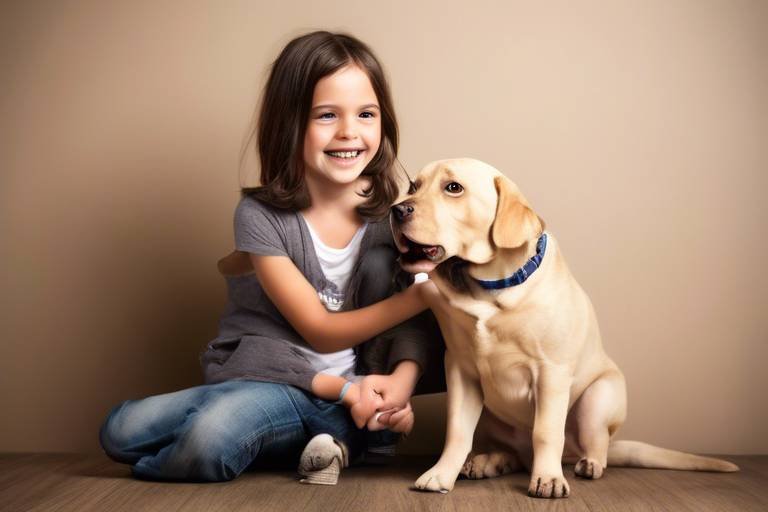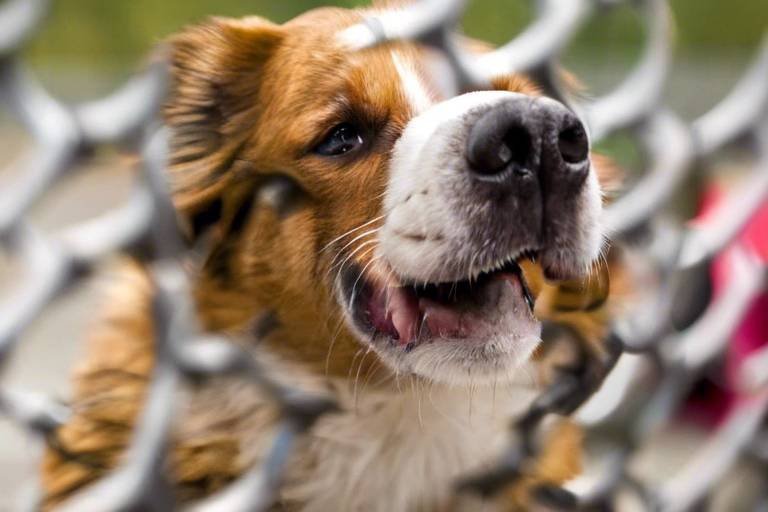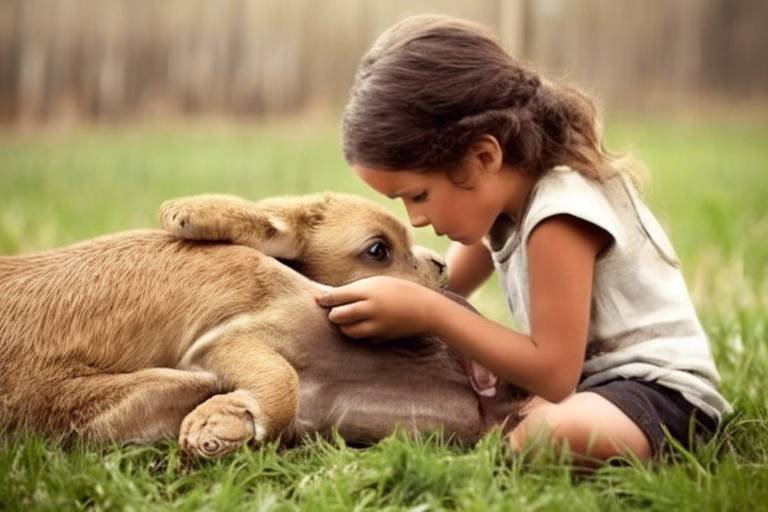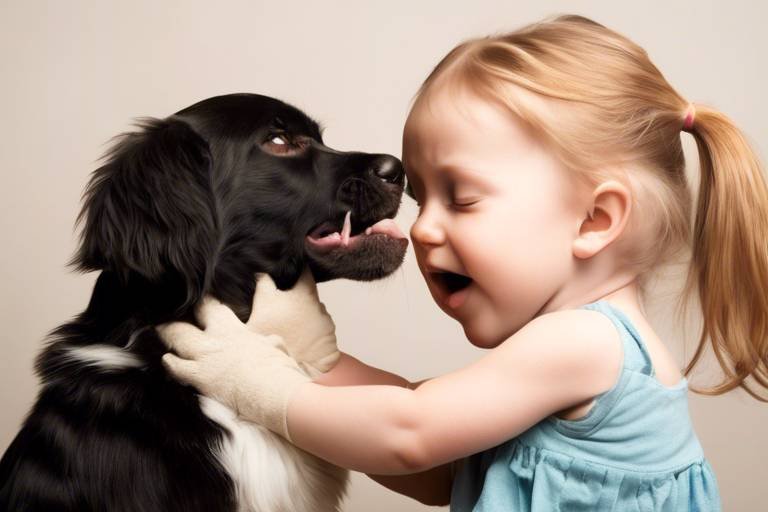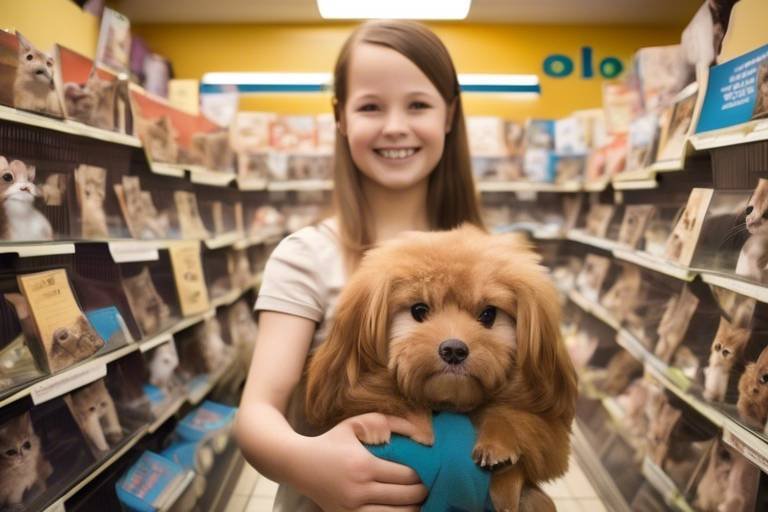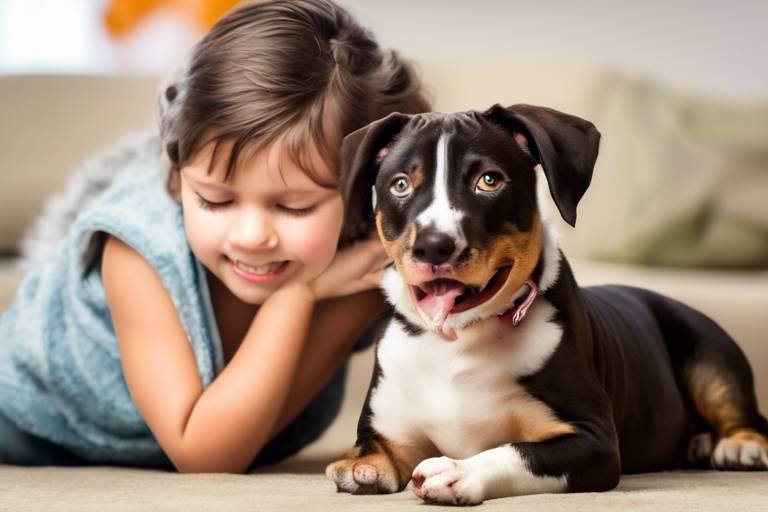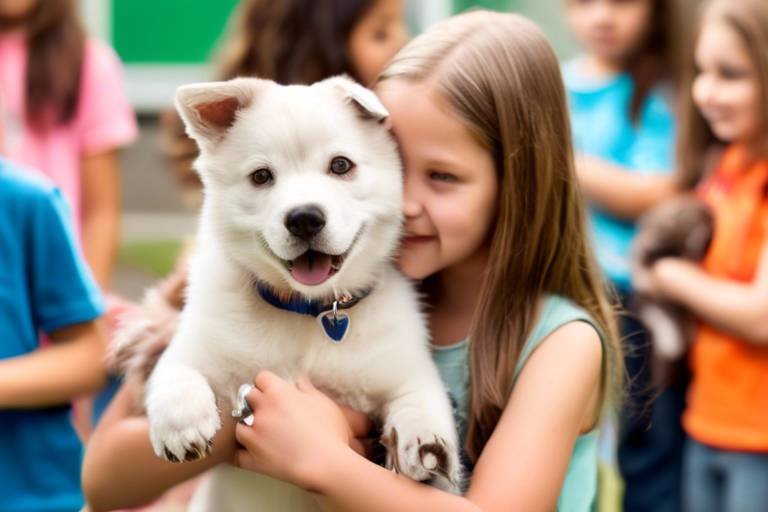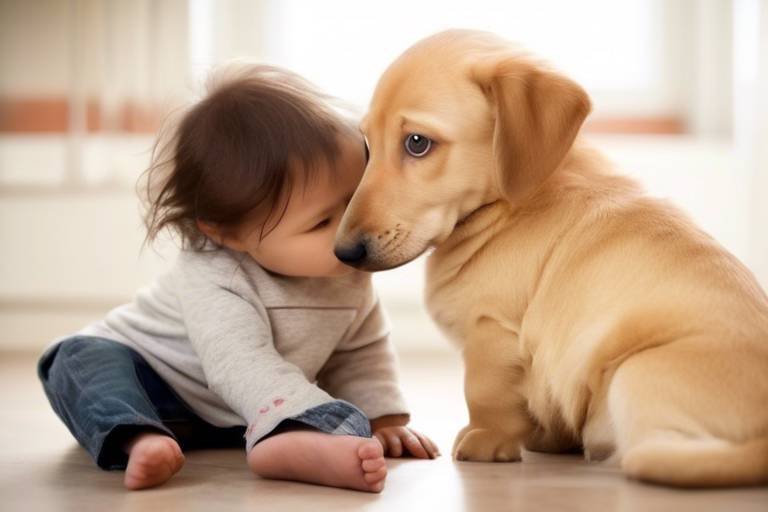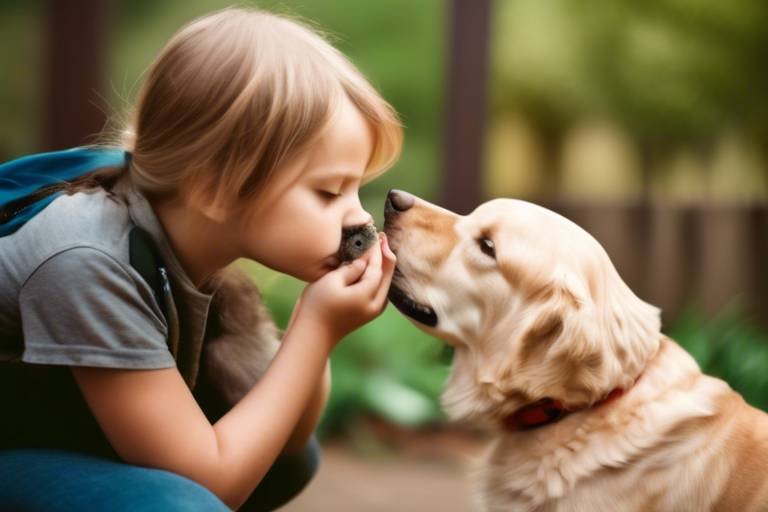The Benefits of Adopting a Pet for Kids
Adopting a pet can be one of the most rewarding experiences for kids and their families. It's not just about having a furry friend to cuddle with; it's about the profound impact that pets can have on a child's life. When you bring a pet into your home, you’re not just adding a new member to the family; you’re opening the door to a world of emotional growth, social skills enhancement, and physical activity. In this article, we will explore the myriad benefits of pet ownership for children, shedding light on how these adorable companions can shape their lives in countless positive ways.
Pets can significantly contribute to children's emotional growth by providing companionship, reducing anxiety, and enhancing empathy. Imagine a child coming home from a tough day at school, feeling overwhelmed and stressed. The moment they see their pet, their worries begin to melt away. Pets offer a unique form of unconditional love and support that helps children navigate their emotions. This bond teaches kids about emotional intelligence, as they learn to recognize and express their feelings while also being sensitive to the needs of their pets.
Adopting a pet can improve children's social skills by encouraging interactions with peers and fostering teamwork in caring for their furry friends. When kids engage in activities like walking a dog or playing fetch, they naturally start conversations with other pet owners, creating opportunities for new friendships. Pets serve as common ground for children to connect, leading to shared experiences that strengthen their social bonds. For instance, organizing playdates that include pets encourages children to socialize in a fun and relaxed environment, promoting positive relationships and communication skills.
Pets create opportunities for kids to bond over shared interests in animal care and activities. This can lead to lasting friendships as they exchange tips on training, grooming, or even fun pet tricks. Imagine a group of kids gathered at the park, each with their dogs, sharing stories and laughter. These interactions not only enhance their social circles but also teach them the value of companionship and teamwork.
Engaging in group activities centered around pets, such as dog walking or training classes, can enhance social interaction and teamwork among children. These activities foster a sense of community, as kids work together to train their dogs or participate in local pet events. It's a fantastic way for them to learn cooperation and build confidence as they navigate the world of pet ownership together.
Caring for a pet requires children to express their needs and feelings, which can enhance their verbal and non-verbal communication skills. Whether it's telling their parents what their pet needs or simply talking to their furry friend, kids become more articulate and confident in expressing themselves. This communication extends beyond their pets; it spills over into their interactions with peers and adults, making them more effective communicators overall.
Having a pet often leads to increased physical activity for children. Regular walks, playtime, and outdoor adventures with pets contribute to a healthier lifestyle. Think about it: how many kids would rather sit on the couch all day versus running around at the park with their dog? Pets naturally encourage kids to get moving, whether it’s chasing a ball, going for a hike, or simply exploring the backyard. This active lifestyle is crucial for their physical development and overall well-being.
Incorporating pets into daily exercise routines helps children develop healthy habits early on, making physical activity a fun and integral part of their lives. For example, walking a dog becomes a daily ritual that not only keeps the pet healthy but also instills a sense of routine in the child. They learn that exercise is not just a chore; it can be an enjoyable part of their day!
Pets encourage children to explore the outdoors, promoting a love for nature and physical play, which is essential for their overall development. Whether it's running through the grass, climbing trees, or discovering new trails, pets invite kids to engage with the world around them. This exploration fosters a sense of curiosity and adventure, crucial traits for lifelong learning.
Owning a pet teaches children about responsibility and commitment. They learn to care for another living being, which instills valuable life skills and a sense of accountability. Daily care tasks, such as feeding, grooming, and walking their pets, help children understand the importance of routine and responsibility. It’s a hands-on way to learn that actions have consequences, and that caring for a pet is a long-term commitment.
Understanding that pets require long-term care fosters a sense of dedication in children, teaching them about the responsibilities associated with caring for another living creature. This lesson is invaluable as they grow older and take on more complex responsibilities in their lives. It prepares them for future challenges, whether in personal relationships or professional settings.
- What age is appropriate for a child to have a pet? It varies, but children aged 5 and up can start learning to care for pets with adult supervision.
- How can I teach my child to be responsible for their pet? Involve them in daily tasks like feeding and walking, and set up a schedule to help them understand routines.
- What type of pet is best for young children? Smaller pets like hamsters or guinea pigs can be great for younger kids, while dogs or cats might be better for older children.
- Can pets help with anxiety in children? Yes, pets provide comfort and companionship, which can significantly reduce anxiety levels in children.

Emotional Development
When it comes to children's emotional growth, the presence of a pet can be a game changer. Pets provide a unique form of companionship that can significantly reduce feelings of loneliness and anxiety in kids. Imagine coming home after a rough day at school, and there’s your loyal dog wagging its tail, ready to greet you with unconditional love. This bond not only brings joy but also teaches children the importance of empathy. They learn to recognize and respond to the emotions of their furry friends, which translates into better emotional intelligence.
Moreover, the responsibilities that come with pet ownership help children navigate their feelings. For instance, when a child cares for a pet, they experience a range of emotions from joy during playtime to sadness when their pet is unwell. This emotional rollercoaster fosters resilience and teaches them how to cope with various feelings. In fact, studies have shown that children who grow up with pets are often more emotionally stable and better equipped to handle stress.
Furthermore, pets can serve as a safe outlet for children to express their emotions. They can talk to their pets about their day, share secrets, or even vent frustrations without the fear of judgment. This kind of interaction not only enhances their verbal skills but also encourages a sense of security. Children learn that it's okay to express their feelings, whether they are happy, sad, or angry.
In addition to emotional support, pets also promote a nurturing environment. When children engage in activities like feeding, grooming, or playing with their pets, they develop a sense of responsibility that is crucial for emotional maturity. They learn to care for another living being, which can be incredibly rewarding and fulfilling. The act of nurturing a pet can instill a sense of purpose and connection that is vital for emotional development.
Ultimately, the bond between children and their pets is a beautiful example of love and compassion. This relationship not only enhances their emotional well-being but also prepares them for future relationships with peers and adults. By understanding and nurturing this bond, parents can help their children cultivate emotional skills that will serve them well throughout their lives.
- How do pets help with anxiety in children? Pets provide companionship and comfort, which can significantly reduce feelings of anxiety and loneliness.
- What emotional skills do children learn from having pets? Children learn empathy, responsibility, and how to express their emotions effectively through their interactions with pets.
- Can pets improve a child's social skills? Yes! Pets can serve as a social bridge for children, helping them connect with peers who share similar interests.
- What types of pets are best for emotional development? Dogs and cats are often ideal due to their social nature, but smaller pets like rabbits or guinea pigs can also provide companionship.

Social Skills Enhancement
Adopting a pet can be a game changer for children, especially when it comes to enhancing their social skills. Imagine a child walking a dog in the park, and suddenly, they are approached by another child who is equally excited about the furry friend. This scenario is not just about the pets; it's about the connections that blossom through them. Pets serve as a bridge, connecting children to their peers in ways that might not happen otherwise. The shared experience of caring for a pet can foster meaningful interactions, encouraging kids to communicate and collaborate.
When children take on the responsibility of caring for a pet, they inherently learn the importance of teamwork. Whether it’s organizing a group dog-walking session with friends or participating in a local pet training class, these activities require cooperation and communication. Kids learn to express their thoughts and feelings, negotiate roles, and support one another as they work together to ensure their pets are happy and healthy. This dynamic not only enhances their social skills but also builds a sense of community among peers.
Moreover, playdates that include pets can be a fantastic way to create a relaxed environment where children can socialize. When kids are engaged in playful activities with animals, they often feel more at ease, which can lead to more open and honest communication. For instance, children might share stories about their pets, discuss their favorite activities, or even collaborate on games that involve their furry friends. This kind of interaction is invaluable in teaching kids how to relate to others, share experiences, and develop friendships.
Additionally, caring for a pet requires children to articulate their needs and feelings. For example, when a dog needs to go for a walk or when a cat is feeling unwell, children must communicate these needs effectively. This practice not only enhances their verbal communication but also improves their non-verbal cues, making them more aware of body language and emotional expressions. As they learn to express themselves better, they become more confident in their interactions with others.
In summary, the social skills enhancement that comes from adopting a pet is profound. From fostering friendships to improving communication, the impact of pets on children's social development is significant. The experiences shared between children and their pets create a foundation for lifelong social skills that will benefit them throughout their lives.
- How do pets help children make friends?
Pets provide common ground for children, allowing them to connect over shared interests in animal care and activities. - Can having a pet improve a child's communication skills?
Yes, caring for a pet encourages children to express their needs and feelings, enhancing both verbal and non-verbal communication. - What types of group activities can children do with pets?
Children can engage in activities such as dog walking, training classes, or playdates, which foster teamwork and social interaction.
Building Friendships
When children adopt a pet, they open the door to a world of friendship and connection. Pets are not just adorable companions; they serve as a bridge between children and their peers, creating a common ground that fosters social interaction. Imagine a group of kids at the park, all gathered around a playful puppy; suddenly, they’re not just strangers, but potential friends united by their love for animals. This shared interest can spark conversations, laughter, and a sense of belonging that is vital during childhood.
Moreover, pets can act as icebreakers. When children talk about their furry friends, they share stories and experiences that resonate with others. This creates a natural environment for bonding. For instance, discussing a pet's quirky habits or sharing tips on training can lead to deeper connections. It's fascinating how a simple topic like pet care can evolve into lasting friendships, as children begin to relate to each other on a personal level.
Additionally, engaging in activities centered around pets, such as organizing playdates, can further enhance these budding friendships. These playdates offer a relaxed atmosphere where children can enjoy each other's company while interacting with their pets. The joy of watching their dogs play together or teaching each other how to train their cats fosters teamwork and cooperation. This not only strengthens their bond with their pets but also with one another.
It's important to note that the friendships formed through pet ownership can be quite meaningful. Children learn to communicate and collaborate with their peers, developing essential social skills that will benefit them throughout their lives. They discover the value of sharing responsibilities, whether it's taking turns walking a dog or helping each other with grooming tasks. This shared responsibility teaches them about teamwork and accountability, further solidifying their friendships.
In summary, pets are more than just animals; they are catalysts for friendship among children. They provide opportunities for social interaction, shared experiences, and the development of essential life skills. So, the next time you see a child with their pet, remember that they are not just playing; they are building connections that could last a lifetime.
- How can pets help children make friends? Pets serve as common interests that bring children together, creating opportunities for social interaction and bonding.
- What types of activities can promote friendships through pets? Activities like playdates, dog walking, and training classes encourage teamwork and communication among children.
- Do pets teach children any social skills? Yes, caring for pets helps children develop communication skills, empathy, and responsibility, which are essential for building friendships.
Group Activities
Engaging in group activities centered around pets can be a fantastic way for children to develop their social skills while having a blast! Picture this: a sunny afternoon at the local park where kids gather not just to play, but to bond over their love for animals. Activities like dog walking, training classes, or even pet-themed playdates create a vibrant atmosphere that encourages teamwork and communication. These interactions are not just fun; they lay the groundwork for lasting friendships and essential social skills.
When children participate in group activities with their pets, they learn to collaborate and navigate social dynamics. For instance, organizing a dog-walking club can teach kids how to work together to ensure each pet is well cared for while also promoting discussions about responsibility and empathy. They might even take turns leading the group, which fosters leadership skills and boosts their confidence. This kind of interaction is invaluable, as it helps children understand the importance of cooperation and the joy that comes from shared experiences.
Moreover, group activities provide an excellent platform for children to express themselves and communicate effectively. Imagine a scenario where kids are training their dogs together. They not only learn commands and tricks but also practice articulating their thoughts and feelings about the process. This kind of environment encourages them to listen to others, share ideas, and even resolve conflicts, making it a rich learning experience.
To illustrate the benefits of these group activities, consider the following table that highlights some popular pet-related group activities and their corresponding social benefits:
| Activity | Social Benefits |
|---|---|
| Dog Walking Groups | Encourages teamwork and communication |
| Pet Training Classes | Enhances listening skills and patience |
| Pet Adoption Events | Fosters community involvement and empathy |
| Pet Playdates | Builds friendships and social networks |
In summary, group activities centered around pets not only provide fun and engaging experiences but also serve as powerful tools for children to enhance their social skills. They learn to communicate better, work as a team, and build lasting friendships—all while enjoying the company of their furry friends. So, the next time you're looking for a way to get your kids socializing, consider organizing a pet-centered group activity. It's a win-win for both kids and pets!
Playdates with Pets
Playdates with pets are not just a fun way for children to socialize; they also provide a unique opportunity for kids to learn essential life skills while enjoying the company of their furry friends. Imagine a sunny afternoon where children gather in a backyard, laughter echoing as they chase after a playful puppy or toss a ball for a curious kitten. This scenario is not just about play; it’s about building connections, fostering friendships, and creating lasting memories.
When children engage in playdates with pets, they are likely to experience a myriad of benefits. Firstly, they learn to share and collaborate with others. For instance, one child might take charge of throwing the ball while another runs to fetch it. This teamwork not only enhances their social skills but also strengthens their ability to communicate effectively. It's like a mini-soccer game, where each player has a role, and together they create a fun and engaging experience.
Moreover, these playdates often lead to meaningful conversations among children. As they discuss their pets’ quirks or share tips on how to train them, they practice verbal communication and active listening. This interaction can be likened to a small community gathering where everyone shares their stories and experiences, creating a sense of belonging and camaraderie.
Additionally, organizing playdates can also introduce children to the concept of empathy. When kids see their friends caring for their pets, they learn to appreciate the feelings and needs of animals. This understanding can translate into a greater awareness of emotions in other aspects of their lives, making them more compassionate individuals. It’s a beautiful cycle of giving and receiving love, where both pets and children thrive.
To ensure a successful playdate with pets, consider the following tips:
- Choose Friendly Pets: Always ensure that the pets involved are sociable and comfortable around children.
- Set Ground Rules: Establish clear guidelines for interactions to keep both children and pets safe.
- Supervise Activities: Always have an adult present to monitor interactions and ensure safety.
- Plan Engaging Activities: Incorporate games like fetch or obstacle courses to keep the children and pets active and entertained.
In conclusion, playdates with pets are a delightful way for children to engage socially while learning valuable lessons about empathy, teamwork, and responsibility. They create a nurturing environment where friendships blossom, and life skills are developed, all while having a blast with their furry companions. So why not plan a playdate today? You might just witness the magic of friendship unfold right before your eyes!
Q: What age is appropriate for children to have playdates with pets?
A: Generally, children aged 3 and up can enjoy playdates with pets, but parental supervision is essential to ensure safety and proper interactions.
Q: How can I ensure my pet is comfortable during a playdate?
A: Introduce the pets slowly, allow them to sniff each other, and monitor their interactions closely. If your pet seems stressed, it’s best to separate them.
Q: Are there specific pets that are better for playdates?
A: Dogs and cats are typically great for playdates, especially if they are socialized and friendly. Avoid exotic pets that may not react well to social interactions.
Q: What activities can we do during a pet playdate?
A: Activities like fetch, tug-of-war, and simple training exercises are great. You can also set up an obstacle course for added fun!
Improving Communication
When it comes to enhancing communication skills in children, pets can play a surprisingly pivotal role. Caring for a pet is not just about feeding and walking; it involves a rich tapestry of interactions that encourage kids to articulate their thoughts and feelings. Imagine a child talking to their dog about their day, sharing secrets, or even expressing their worries. This simple act of verbalizing emotions helps children develop a vocabulary that can be crucial for effective communication.
Moreover, pets can serve as a bridge for children to express their needs. For instance, when a child notices their pet is hungry or wants to go outside, they learn to communicate that to their parents or guardians. This not only reinforces their understanding of verbal communication but also teaches them to recognize non-verbal cues—like a wagging tail or a sad whimper. By observing how pets express their emotions, children can gain insights into empathy and understanding, which are vital components of effective communication.
In addition, the responsibility of caring for a pet often requires children to engage in discussions about the pet's needs and health. They might need to explain to their parents why their pet requires a vet visit or how to care for an injury. This fosters a sense of accountability and encourages children to articulate their thoughts clearly and confidently. As they navigate these conversations, their verbal skills improve significantly.
To further illustrate the benefits, here’s a brief overview of how pets can aid in improving communication:
| Aspect of Communication | How Pets Help |
|---|---|
| Verbal Skills | Talking to pets encourages children to express themselves and build vocabulary. |
| Non-Verbal Skills | Observing pet behavior helps children understand body language and emotions. |
| Empathy | Caring for pets fosters an understanding of others' feelings, enhancing emotional intelligence. |
| Responsibility | Explaining pet care needs to adults encourages clear articulation and accountability. |
In essence, the relationship between children and their pets can be a powerful catalyst for improving communication skills. By nurturing this bond, kids not only learn how to speak more effectively but also how to listen and empathize with others. It’s a beautiful cycle of growth that benefits both the child and their furry companion.
- How can a pet help my child with anxiety?
A pet can provide companionship and unconditional love, which can significantly reduce anxiety levels in children. - What age is appropriate for a child to start caring for a pet?
Children as young as 5 can start taking on small responsibilities, like feeding or brushing a pet, with adult supervision. - Are there specific pets that are better for children?
Generally, dogs and cats are great options, but small animals like guinea pigs or rabbits can also be good choices for younger kids. - How do pets teach responsibility?
Owning a pet requires daily care, which teaches children the importance of routine and commitment.

Physical Activity Encouragement
Having a pet is like having a built-in buddy who can motivate children to get off the couch and enjoy the great outdoors. Pets are not just adorable companions; they are also fantastic catalysts for physical activity. Imagine a child with a playful puppy, eagerly throwing a ball and racing after it, giggling with delight. This simple act of play not only provides joy but also contributes to the child's overall health and well-being. Regular interactions with pets can significantly enhance a child's level of physical activity, promoting a more active lifestyle that can last a lifetime.
One of the most enjoyable aspects of pet ownership is the daily exercise routine that it naturally creates. Whether it's taking a dog for a walk, playing fetch in the park, or even dancing around the living room with a playful cat, these activities encourage kids to move their bodies and enjoy physical exertion. In fact, studies show that children who own pets are more likely to engage in outdoor play, which is crucial for their physical development. The joy of having a pet can transform exercise from a chore into a fun and exciting adventure.
Moreover, pets can inspire children to explore their surroundings. A child walking a dog is not just getting exercise; they are also discovering the beauty of nature. Every walk can turn into a mini-adventure filled with new sights, sounds, and experiences. This outdoor exploration not only boosts physical fitness but also fosters a love for nature and the environment. It’s like turning every stroll into a treasure hunt, where the treasures are the wonders of the world around them!
To illustrate the benefits of physical activity with pets, consider the following table that highlights various activities and their corresponding health benefits:
| Activity | Health Benefits |
|---|---|
| Walking the Dog | Improves cardiovascular health, strengthens muscles, and promotes weight management |
| Playing Fetch | Enhances coordination, agility, and endurance |
| Agility Training | Increases strength, balance, and flexibility |
| Outdoor Exploration | Boosts mental health, reduces stress, and fosters a connection with nature |
In conclusion, pets are incredible companions that not only bring joy and love into our lives but also play a vital role in encouraging children to be more physically active. The bond formed through shared activities fosters a sense of adventure and promotes a healthier lifestyle. So, if you're considering adding a furry friend to your family, remember that you're not just gaining a pet; you're investing in your child's health and happiness!
- How can pets help my child stay active?
Pets encourage outdoor play, walks, and various activities that promote physical exercise. - What type of pet is best for encouraging physical activity?
Dogs are often the best choice, as they require regular walks and playtime, but other active pets like cats can also engage children in play. - Are there specific activities that are better for physical fitness?
Activities like walking, playing fetch, and agility training are excellent for improving fitness levels in children.
Daily Exercise Routines
Incorporating pets into daily exercise routines can be a game changer for kids. Imagine this: instead of just lounging around after school, your child can grab a leash and head out for a walk with their furry friend. This simple act not only gets them moving but also makes exercise feel like an adventure rather than a chore. Walking a dog can turn into a delightful exploration of the neighborhood, where every tree, bush, and passing squirrel becomes an opportunity for excitement and engagement. It's a win-win situation!
Moreover, pets can motivate children to be more active in various ways. For instance, playing fetch with a dog can lead to bursts of energy that keep kids on their toes. Not to mention, activities like running around in the backyard or at a local park can foster a love for outdoor play. When children see their pets enjoying themselves, they're more likely to join in on the fun, making physical activity a natural part of their daily routine.
To illustrate the benefits of daily exercise routines with pets, consider this table that outlines different activities kids can enjoy with their pets:
| Activity | Description | Benefits |
|---|---|---|
| Walking | Daily walks around the neighborhood or park. | Improves cardiovascular health and builds stamina. |
| Fetch | Throwing a ball or toy for the pet to retrieve. | Enhances coordination and encourages running. |
| Agility Training | Setting up an obstacle course for pets. | Promotes teamwork and problem-solving skills. |
| Playdates | Organizing play sessions with other pets. | Encourages social interaction and physical play. |
Additionally, the beauty of having a pet is that they thrive on routine, which can help kids establish their own healthy habits. For example, setting a specific time each day for walks or playtime can create a structured routine that kids can look forward to. This not only helps in maintaining a healthy lifestyle but also teaches them the importance of consistency and discipline. In essence, pets can transform mundane exercise into exciting adventures!
So, whether it’s a brisk walk, a game of fetch, or simply exploring the great outdoors together, having a pet can significantly enhance a child's physical activity levels. It’s not just about getting fit; it’s about creating memories and building a bond that lasts a lifetime. With every wag of the tail or playful bark, kids are reminded that staying active can be fun and fulfilling.
- What type of pet is best for encouraging exercise? Dogs are generally the best choice as they require regular walks and playtime, but other pets like active cats can also engage children in play.
- How can I motivate my child to exercise with their pet? Make it fun! Plan activities like fetch, agility courses, or trips to the park to keep them excited about exercise.
- Is there an age limit for children to start exercising with pets? Generally, children as young as 5 or 6 can start engaging in simple activities with pets, but supervision is important for safety.
Outdoor Exploration
When you think about the great outdoors, what comes to mind? Fresh air, the sound of rustling leaves, and the thrill of adventure! Now, imagine experiencing all of that with a furry companion by your side. Owning a pet can transform a mundane park visit into an exciting expedition filled with discovery. Pets, especially dogs, are natural explorers. They have an innate curiosity that encourages children to step outside and explore the world around them. This exploration not only fosters a love for nature but also provides numerous physical and mental health benefits.
Whether it's a leisurely stroll around the neighborhood or an adventurous hike through the woods, pets motivate kids to be active. The act of walking a dog, for instance, is not just a chore; it becomes a delightful adventure. Children learn to appreciate their surroundings, notice the beauty of blooming flowers, and listen to the cheerful chirping of birds. Every outing becomes an opportunity to discover something new. They might spot a squirrel darting up a tree or find a unique rock that sparks their imagination.
Moreover, outdoor exploration with pets is a fantastic way to cultivate a sense of responsibility in children. As they navigate different environments, they learn to keep their pets safe from hazards like busy roads or prickly bushes. This awareness helps instill a sense of caution and care that translates into other aspects of their lives. The bond that forms during these outdoor adventures is invaluable, as it teaches children about trust and teamwork. They learn to communicate with their pets, understanding their needs and moods, which enhances their empathy and emotional intelligence.
In addition to the physical benefits, outdoor activities with pets can also improve mental well-being. Studies have shown that spending time in nature reduces stress and anxiety, making it a perfect antidote for the hustle and bustle of daily life. Imagine the joy of watching your child laugh and play with their pet in a sunlit park. It's moments like these that create lasting memories and foster a healthy mindset.
So, the next time you consider taking your child out, think about bringing along a pet. Not only will it make the outing more enjoyable, but it will also enrich your child's life in countless ways. Embrace the adventure, and let the exploration begin!
- What are the best pets for young children?
While dogs and cats are popular choices, smaller pets like rabbits, guinea pigs, and hamsters can also be great companions for young children. It's essential to consider the child's age and maturity level when choosing a pet.
- How can pets help with my child's social skills?
Pets can serve as a social bridge, helping children connect with peers who share similar interests. Group activities like dog walking or pet care classes can enhance teamwork and communication skills.
- What responsibilities should my child take on when caring for a pet?
Children can help with feeding, grooming, walking, and cleaning up after their pets. These tasks teach them about routine and the importance of caring for another living being.

Teaching Responsibility
Owning a pet is not just about cuddles and playtime; it’s a profound journey into the world of responsibility and commitment. When children take on the role of a pet owner, they embark on a path that teaches them invaluable life skills. Imagine a child learning that feeding their furry friend at the same time each day is not just a chore, but a commitment. This simple act instills a sense of routine and discipline that translates into other areas of their lives.
One of the most significant lessons children learn from pet ownership is the importance of daily care. Tasks such as feeding, grooming, and walking their pets become part of their daily routine. For instance, when a child is responsible for ensuring their dog gets its daily exercise, they not only learn about the needs of another living being but also about time management and prioritization. These responsibilities can be broken down into manageable tasks, fostering a sense of achievement when completed.
To illustrate this, let’s look at a simple table that outlines some daily care tasks and their corresponding lessons:
| Daily Care Task | Lesson Learned |
|---|---|
| Feeding the pet | Understanding the importance of routine |
| Walking the pet | Commitment to physical activity |
| Grooming | Caring for another living being |
| Training sessions | Patience and consistency |
Moreover, children learn that pets are not just toys that can be put away when they’re done playing. Pets require long-term care, which teaches kids about dedication. They begin to understand that their furry friends depend on them for everything, from food and water to love and attention. This realization can be a powerful motivator for children to step up and take their responsibilities seriously.
In addition to these lessons, having a pet can also spark conversations about empathy and compassion. When children see their pets in need, whether it’s a hungry belly or a playful spirit that needs to be nurtured, they learn to respond with care. This emotional connection deepens their understanding of responsibility, as they realize that caring for a pet is about more than just fulfilling basic needs; it’s about forming a bond that requires effort and love.
Ultimately, the journey of pet ownership equips children with essential skills that will serve them well throughout their lives. They learn to be accountable not just for their pets, but for their actions in general. As they grow older, these lessons will help them navigate the complexities of life, making them more responsible individuals. So, if you’re considering adopting a pet, remember that it’s not just a new addition to the family; it’s an opportunity for your child to learn, grow, and take on new responsibilities.
- What age is appropriate for a child to have a pet?
Generally, children around the age of 5 and older can start taking on responsibilities for a pet, depending on the pet's size and temperament.
- How can I teach my child to be responsible for a pet?
Start with small tasks like feeding and gradually increase their responsibilities as they show they can handle them.
- What type of pet is best for teaching responsibility?
Smaller pets such as hamsters or guinea pigs can be easier for younger children, while dogs can provide more interactive responsibilities.
- How do pets help with emotional development in children?
Pets provide companionship, reduce anxiety, and help children learn empathy through caring for another living being.
Daily Care Tasks
When it comes to owning a pet, the are not just chores; they are vital lessons in responsibility and commitment for children. Imagine a child waking up each morning, excited to start the day by checking on their furry friend. This routine fosters a sense of purpose and belonging, which is essential for their emotional and social development. The simple act of feeding a pet or taking it for a walk can transform mundane tasks into meaningful experiences.
Daily care tasks can include a variety of activities, each offering unique lessons. For instance, feeding the pet teaches children about nutrition and the importance of a balanced diet. Grooming not only keeps the pet clean but also helps children understand the significance of hygiene and care. Walking the dog can turn into an adventure, where children learn about time management as they plan their day around their pet’s needs.
Here are some common daily care tasks that children can help with:
- Feeding: Kids can take charge of measuring out the right amount of food and ensuring their pet has fresh water.
- Grooming: Brushing the pet’s fur not only keeps it looking good but also strengthens the bond between the child and the animal.
- Walking: This is not just exercise for the pet; it’s an opportunity for the child to learn about responsibility and routine.
- Cleaning: Whether it’s picking up after the pet or cleaning their living space, this teaches children about accountability.
Engaging in these tasks allows children to develop a sense of routine and accountability. It’s not uncommon for parents to notice a positive shift in their child’s behavior as they take on these responsibilities. Suddenly, they are more aware of their surroundings, more considerate of others' needs, and even more willing to help out around the house. This transformation is akin to planting a seed and watching it grow into a strong tree, deeply rooted in values of care and responsibility.
Moreover, these daily tasks can lead to meaningful conversations between parents and children. Discussing why certain tasks are important encourages children to think critically about their actions and the impact they have on their pets. In this way, owning a pet becomes a learning experience that extends beyond just caring for an animal; it becomes a foundation for teaching essential life skills.
In conclusion, the daily care tasks associated with pet ownership are much more than just a list of chores. They are opportunities for children to learn, grow, and develop vital skills that will serve them throughout their lives. By nurturing their pets, children also nurture themselves, learning the value of commitment and the joy that comes from caring for another living being.
- What age is appropriate for a child to start helping with pet care? Generally, children as young as 5 can start with simple tasks like feeding and filling water bowls, while older children can take on more responsibilities.
- How can I encourage my child to participate in pet care? Make it fun! Use games, rewards, or create a schedule that includes pet care tasks, so it feels like an adventure rather than a chore.
- What if my child loses interest in pet care? Try to re-engage them by introducing new activities, like training sessions or outdoor adventures with the pet, to spark their interest again.
Long-Term Commitment
When a child decides to adopt a pet, they are not just bringing home a new friend; they are embarking on a journey of . This journey is akin to planting a seed and nurturing it to grow into a strong, vibrant tree. Just as a tree requires water, sunlight, and care, a pet needs consistent attention, love, and responsibility. Children learn early on that their furry companions rely on them for everything, from food and shelter to affection and exercise. This realization can be both exciting and daunting, but it ultimately teaches invaluable life lessons.
Understanding that pets are not temporary fixtures but lifelong companions instills a profound sense of dedication in children. They begin to grasp the concept of responsibility, which is an essential skill as they navigate through life. For instance, when a child is tasked with feeding their pet on schedule, they learn the importance of routine. It’s not just about feeding; it’s about being accountable for another living being's well-being. This sense of responsibility can extend beyond the pet, influencing how they approach their homework, chores, and even friendships.
Moreover, this commitment also introduces children to the realities of life and death. Pets have a limited lifespan, and children must learn to cope with the idea of loss and grief. While this may sound heavy, it’s a crucial part of emotional development. They learn to cherish every moment spent with their pets, understanding that love is both a joy and a responsibility. The bond formed through shared experiences, such as walks in the park or cozy cuddle sessions, becomes a treasure trove of memories that shape their emotional landscape.
To illustrate the importance of this long-term commitment, consider the following table that outlines the various aspects of pet care that children can learn:
| Aspect of Care | Skills Learned |
|---|---|
| Feeding | Routine, time management, nutritional knowledge |
| Grooming | Attention to detail, empathy, hygiene awareness |
| Walking | Physical activity, responsibility, outdoor exploration |
| Veterinary Visits | Understanding health care, compassion, financial awareness |
In conclusion, the commitment to a pet is a multifaceted journey that enriches a child’s life in countless ways. It’s about learning to care for others, understanding the cycles of life, and developing a sense of responsibility that will serve them well into adulthood. Just like the nurturing of a tree, the commitment to a pet requires patience, love, and dedication, but the rewards—unconditional love and companionship—are truly worth it.
- What age is appropriate for a child to have a pet? Generally, children aged 5 and older can start taking on pet care responsibilities with adult supervision.
- How can I teach my child to be responsible for their pet? Start with small tasks like feeding and gradually introduce more responsibilities, such as walking and grooming.
- What are the best pets for children? Smaller pets like hamsters, guinea pigs, or cats are often great starter pets for kids, but dogs can also be wonderful companions if the family is ready for the commitment.
Frequently Asked Questions
- What are the emotional benefits of having a pet for kids?
Having a pet can significantly enhance a child's emotional well-being. Pets provide companionship, reduce feelings of loneliness, and help children develop empathy by teaching them to care for another living being. This bond can lead to improved emotional intelligence as kids learn to express their feelings and understand those of their pets.
- How do pets improve social skills in children?
Pets can serve as a social catalyst for kids, encouraging them to interact with peers and build friendships. Activities like dog walking or participating in training classes create opportunities for teamwork and communication, helping children develop essential social skills in a fun and engaging way.
- Can having a pet encourage physical activity in children?
Absolutely! Pets require regular exercise, which naturally leads to more physical activity for kids. Whether it’s taking a dog for a walk, playing fetch, or simply running around in the yard, having a pet makes staying active enjoyable and can instill healthy habits from a young age.
- What responsibilities do children learn from pet ownership?
Owning a pet teaches children about responsibility and commitment. They learn to participate in daily care tasks such as feeding, grooming, and walking their pets. This hands-on experience helps them understand the importance of routine and the long-term dedication required to care for another living creature.
- How can pets help children with anxiety?
Pets have a calming effect and can help alleviate anxiety in children. The presence of a furry friend can provide comfort and security, making it easier for kids to cope with stress. The routine of caring for a pet also offers a sense of stability, which can be particularly beneficial for anxious children.
- What age is appropriate for a child to start caring for a pet?
The appropriate age can vary depending on the child's maturity level and the type of pet. Generally, children as young as five can start taking on simple tasks like feeding or brushing, while older kids can handle more responsibilities. It's essential to supervise and guide them to ensure they learn properly and safely.
- Are certain pets better for kids than others?
Yes, some pets are generally more suitable for children. Dogs and cats are popular choices, but smaller pets like guinea pigs, hamsters, or rabbits can also be great for younger kids. It's important to consider the pet's temperament, size, and care needs to ensure a good match for your family.
- How can I prepare my child for the responsibility of pet ownership?
Start by having open discussions about what it means to care for a pet. Involve your child in researching different types of pets and their needs. You can also begin with small tasks related to pet care, like visiting a friend’s pet or volunteering at an animal shelter, to give them a taste of what’s involved.


